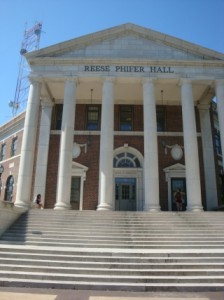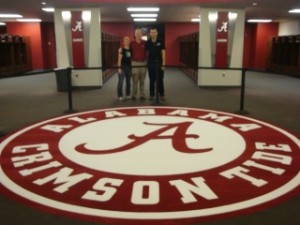The first thing an observant traveler might note when flying between Europe and the United States is the difference between airport stores offerings; even major European hubs tend to be quite essential and have, for instance, only a few cafeterias/delis. In contrast, major airports in the U.S.A. offer myriad food choices: pizzas, sandwiches, burgers, ribs, and even the occasional fruit stall. This merely complements a wide range of stores selling books and clothes, sweets and souvenirs, and other more or less useful items that might appeal to globetrotters desperately trying to kill time. Consumerism meets travelers at continental gateways.
Less than 14 hours after stepping out of Birmingham-Shuttlesworth International Airport in Birmingham, Alabama, it was my turn to propel intercultural exchange: that is when my first visiting lecture at the College of Communication and Information Sciences of the University of Alabama was scheduled. Three times in as many days I had the opportunity to speak about notions of identity in Slovenian sports broadcasting as an expression of cultural diversity.

The Reese Phifer Hall, home of the College of Communication and Information Sciences and venue of my three guest lectures
Broadcast media industries in the United States and in Europe obviously have a common denominator, yet the differences between them can be quite prominent. In Europe, for instance, sports broadcasters are usually considered to be journalists (and thus presumably subject to journalistic professional standards). Then, public service broadcasting is considered to be the trend-setter in the Old World’s broadcast media industry—something highly unlikely in a nation where the very existence of an indigenous tax-funded television network is inconceivable. A more specific difference between Slovenian and American media (specifically, between the two nations’ Olympic broadcasters, TV Slovenija and NBC) is the fact that American announcers would certainly be fired if they discussed the sex-appeal of hammer thrower Clarissa Claretti, or noting upon a power shortage that a monitor is black as if the commentator met Kenenisa Bekele in a tunnel. In Slovenia, they are not. These and other characteristics of Slovenian sportscasting discourse led among other to brief, but hopefully insightful discussions on differing notions of political correctness and freedom of speech with University of Alabama students. One of the key points of my lectures were that societies need to be studied from different aspects and standpoints, and cultivation effects of television as a medium need to be kept in mind. The tube directs, as much as reflects reality.
I hope to have fulfilled the expectations of Andy Billings, the Ronald Reagan Chair of Broadcasting at the College of Communication and Information Sciences who offered me the opportunity to lecture at the University of Alabama. I am also grateful to award-winning television academic and professional Michael Bruce from the Department of Telecommunication and Film, and to sports-loving rhetoric and public address specialist Meredith Bagley for from the Department of Communication Studies for inviting me to speak in their courses.
Among the things that struck me during the short but insightful visit at the university was the institution’s policy to have lecturers teach some of the core courses. This way, good lecturers that do not aspire to become researchers are allowed to engage in what they do best, while top-notch scholars can teach in specialized courses and dedicate more time to research. Both students and faculty benefit from the arrangement.
One of the events I attended while visiting the university was the Alabama Forensic Council National Showcase. The 90-minute event showcased University of Alabama students scheduled to compete at the national forensics (competitive public speaking) tournament during the Easter weekend. I saw some astounding performances and it would probably make sense to introduce similar programs at universities outside English-speaking countries. Another initiative I appreciated was the Crimson White, a student-run newspaper published four times a week and with a circulation of 14,000 that reports on topics of local and campus-wide relevance.
Arguably the most iconic feature of the University of Alabama, however, is its football team. Earlier this year, the Crimson Tide won its fourteenth national title, and about half the cars in Tuscaloosa seem to have ‘Bama plates or other gadgets exhibiting their support for the team. As my lectures took place in March, I did not have the opportunity to attend a game; I was, however, given the honor of being taken to a very exclusive full tour of the Bryant-Denny stadium, a cathedral-like building that dominates the horizon in Tuscaloosa and seats 101,821 people. Typically, only donors and other very distinguished guests are offered stadium tours—this is not something that is offered to members of the general public—so seeing a million-dollar skybox and the Crimson Tide locker room from the inside was certainly a great privilege I was offered.
After three days and three lectures in Tuscaloosa, Alabama, I traveled to East Peoria, Illinois, for the Summit on Communication and Sport. Thoughts and experiences from this part of the journey will be the topic of my next blog post.
Until then…Roll Tide!

